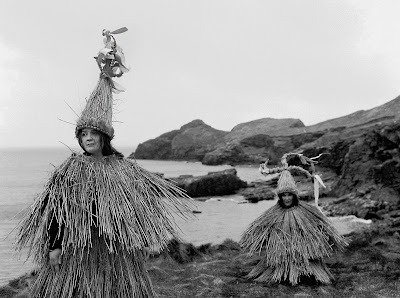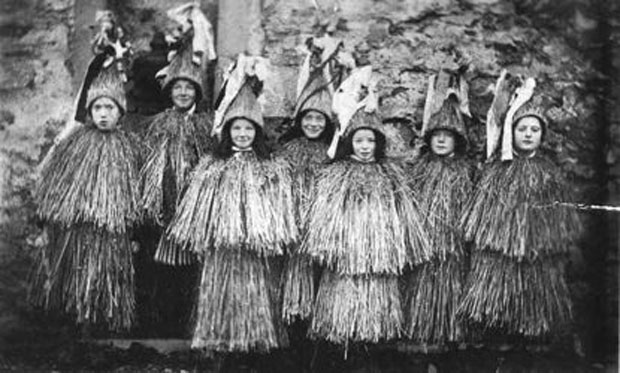From the Shetland Islands come the “straw men” called skeklers, “masks” who played a specific role in the celebrations of Halloween, New Year and even in peasant marriages.
They are fertility “wheat spirits”, the local version of the “begging eggs” tradition spread throughout Europe: “Skekling is an old Shetland folk tradition. A Skekler is the name for a type of disguised person dressed in a distinctive straw costume; it is a variant of the term ‘guiser’. Skeklers would go round the houses at Halloween, New Year, and turn up at weddings in small groups performing fiddle music in return for food and drink.”

“Singing the eggs” was part of the ritual beginning of the new year still widespread in Piedmont (although moved to March-April) and of a consolidated tradition in the Italian South (singing of the Strina): the eggs are certainly symbols of rebirth, good health and good harvest, it is the so-called “sympathetic magic” but it makes me think of the use (extensively documented in legends and fairy tales) of egg shells as “exorcism” against fairy pranks and in particular of the Servan ( silvanotti, sarvanot, sarvan, the peasant goblins), in the old days the peasants scattered the shells in front of the doors of the stables to prevent fairy jokes to the cattle; or the boiling eff shells in “counter-spell” against the Changeling. Furthermore the Irish leprechaun, elf of the woods, is master (or guardian) of great quantities of gold – just as it is said of the wild man.
THE WILD MAN
The straw man’s mask (with the blackened face) and the disguised voice was described by Samuel Hibbert in his Description of the Shetland Islands in 1822, when the tradition was already dying out. Here is an accurate description dating back to 1850: “The kitchen was full of beings, whose appearance, being so unearthly, shook the gravity of my muscles and forced a cold sweat to ooze from every pore in my body… [they] stood like statues. One was far above the rest and of gigantic dimensions. eyes, mouth, or noses they had none, nor at least a trace of their countenance.
They kept up an incessant grunt — a noise partly resembling a swine or turkey cock. Their outer garments were as white as snow ans consisted of petticoats below and shirts on the outside with sleeves and collars. They were veiled and their headdresses or caps were about 18 inches in height and made of straw twisted and plaited. each cap terminated in three or four cones of a crescent shape, all pointing backwards and downwards with bunches of ribbons of every colour raying from the points of the cones.” (from here)
We are in the presence of the umpteenth variant of the Wild Man between myth and ritual, here in his vegetable exception of Man of the Woods (a Jack in the Green of the dark part of the year) that at the end of winter “wakes” the wheat and promotes the germination. Thus the mask of the “straw man” screams (in a beastly way, not a human one) and brings confusion by becoming an instrument of the magic ritual.
There is also a photographic record of these magical creatures, a group of boys photographed in Fetlar in 1909 while there is evidence of tradition up until 1958, the tail of a ritual whose meaning was lost.

Da Skeklers
A lost tradition that in many parts of Shetland is trying to revive (see the photo shoot by Gemma Ovens )
A significant contribution comes from the musical group “Fiddlers’ Bid” that have included in their album “All dressed in Yellow” (2009) the traditional song Da Skeklers and reconstructed the straw costumes of these disturbing masks.
The melody is in set with “Aamer August” (Estonia), the march “Hunter’s Hill” (Scotland); “Sigurd ‘or Gord’s Spring” (from the Shetland Islands played by Catriona McKay’s harp); From Skeklers (from the Shetland Islands ).
So they write in the notes “People like these turning up at your isolated house in the middle of the winter. They would have been good enough to open the door?“
In the occasion of the most important festival of the archipelago, Up Helly Aa , a team had the idea of recovering the straw man’s mask; already in 2007 for the opening of the new Shetland Museum, Euan Balfours had recreated the costume based on the photographic archives: the peculiarity of the costume lies in the conical straw hat with woven tip and decorated with ribbons, so it was discovered that the old men still remembered how the various ways of weaving the costume were synonymous with a typicality of the community; we also learn that the face of the mask had to be concealed, not simply dyed black, but veiled (cf)
Clutching at Straws (Clint Watt)
LINK
Massimo Centini “L’uomo selvatico” (1989)
http://www.knitbritish.net/clutching-at-straws-fragments-of-a-shetland-tradition/
http://www.documentscotland.com/skeklers-skekling-shetland-scottish-photography/
http://museumofwitchcraftandmagic.co.uk/news/skekler-costume-on-loan/
